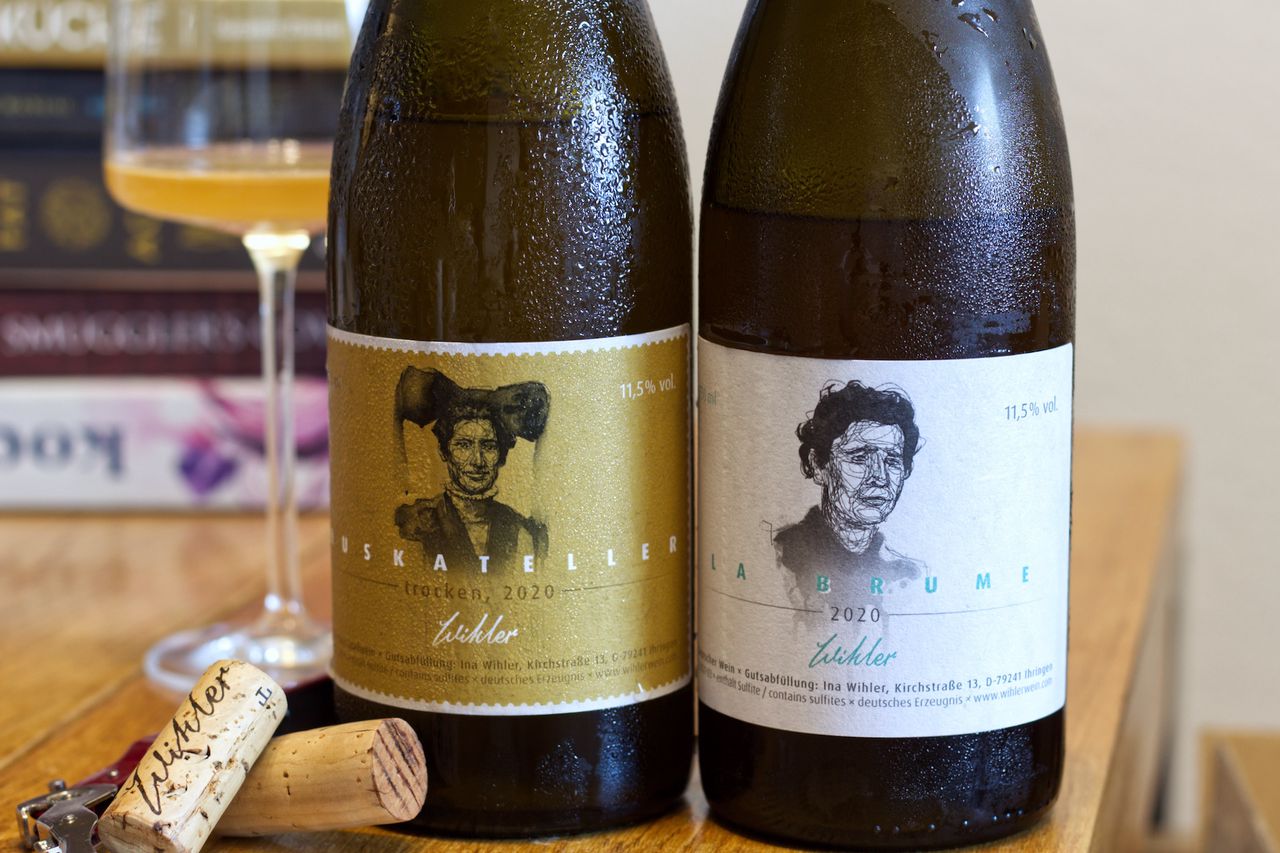Two Bottles Ina Wihler
We drink two bottles of Landwein from Ina Wihler: a Muskateller and a La Brume, both 2020.

Labels sell wine. Not only with food is it so that the eye takes part in the experience, no it also contributes strongly when drinking and in the end it is thanks to the eye that these two bottles first landed in the virtual shopping basket and then in the glass. I had never heard of Landweingut Ina Wihler, but found the labels exciting and just bought them. The pictures on the bottles are by Freiburg artist Michael Genter. The winery is located in Ihringen at the Kaiserstuhl and the lady on the Muskateller wears the typical traditional clothes from there. I like that idea. Ina Wihler has taken over the vineyards of her grandmother and cultivates her 2.5 hectares of land with a lot of manual work close to nature. As already mentioned, we taste two wines from her. The 2020 Muskateller comes from steep slopes of loess and volcanic weathered soils. The grapes are partially mashed whole, that is, fermented intra-cellular semi-carbonique with their own yeasts. It then remains on full lees in steel tanks before being bottled with little sulfur and without filtering. La Brume, also from 2020, is a more radical natural wine and is made from various white grape varieties. Included are Weissburgunder, Müller-Thurgau and Silvaner (if I can trust the various information I found). Part of the grapes are fermented in clay amphora without stems but with skins and left on the mash for a while. It is bottled without the addition of sulfur and, as you can easily see from the photo, also without filtration. Both wines have a pleasantly low alcohol content of 11.5%.
We start the evening with this La Brume. The nose is super funky and natural immediately after opening. I did not expect anything else from wine that comes at least partially from the amphora. However, it is not exhausting or intrusive but surprisingly elegant and pleasant fragrance. We smell slightly muddy yellow fruit, peach jam without sweetness, pith, a few floral notes and black tea kombucha. On the tongue, however, the fruit doesn’t arrive at all. There’s a lot of structure and coolness. The acidity has pull, of course its also funky right here, but still somehow also clean and surprisingly easy to drink. Let’s see what air and time do.
The night softens the wine, more citrus, grapefruit, lemongrass and onward the black tea. The acidity continues to bring decent pull to the tongue. The tannin is stronger than it appeared on the first night, the nose smokier and a bit creamier. If you’ve never dared to try orange or amphora before, you can definitely take a chance with this. I like it.
Ina Wihler describes the Muskateller on the homepage as rather meager and mineral. We can agree on the minerality, but either we have very different definitions of meager, or it’s simply that for me personally this kind of aromatic still seems a bit more blatant than it is. It’s at least a little bit of an endboss to me. Only for me mind you, because the better half is slurping the glass empty faster than you can refill it. The nose is super aromatic. Not sweet, not cheesy and I can absolutely acknowledge the quality of the fruit, but the amount of cassis and passion fruit that hits me is just too much right after opening. Fortunately that recedes a bit with air, it becomes spicier, more herbal and gets a touch of bitter lemon in the mouth. If you could just reduce the wine to what happens on the tongue, I’d be a fan too. The freshness, the crisp acidity, the very light structure, it’s really good. I can imagine that the acidity with its slight natural impact might be too stark for some Muskateller lovers, but for me it is still integrated and clean enough that it fits. Overall, however, other people at the table like it much more than I do, and I’ll stick with the La Brume.